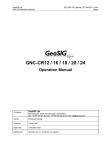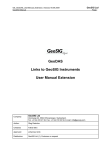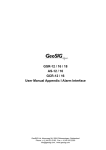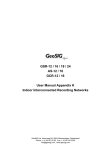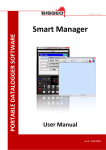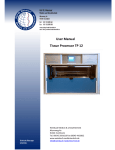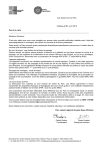Download AC-23 Accelerometer User Manual
Transcript
GeoSIG Ltd AC-23 Accelerometer Manual GS_AC-23_UserManual_V08.doc/18.03.2011 Page 1 AC-23 Accelerometer User Manual Author: GeoSIG Ltd Ahornweg 5A, 5504 Othmarsingen, Switzerland, Tel: +41 44 810 21 50, Fax: +41 44 810 23 50, E-mail: [email protected] Serge Rudaz Checked: Lukas Gätzi Approved: Johannes Grob Distribution: GeoSIG Ltd (1), Customer on request Company: GeoSIG Ltd AC-23 Accelerometer Manual GS_AC-23_UserManual_V08.doc/18.03.2011 Page 2 DOCUMENT REVISION Date 15.04.95 11.04.00 05.07.01 Version 0 1 2 Author SR JG SR Checked JP GCO JG 30.05.2003 06.06.2003 3 4 LG LG JG JG 05.12.2003 21.04.2004 05.05.2006 12.12.2007 5 5 6 7 SR JG SR TB JG JG JG TB 13.12.2007 18.03.2011 8 8 TB THL TB TAB Description Created Format/Font changes Update pictures and connector description for new 12 poles version. Added principle of operation. Changes for new housing Corrected axis polarity for new housing. Movement in axis-direction gives positive response. Updated Reformatted Adapted to new DH housing Adapted to new sensor housing File name and title change Detailed sensor full scale & offset adjustment Board connector pinning added GeoSIG Ltd AC-23 Accelerometer Manual GS_AC-23_UserManual_V08.doc/18.03.2011 Page 3 TABLE OF CONTENT 1 ELECTRICAL CONNECTION ............................................................................................................. 4 1.1 MAIN CONNECTOR PIN ASSIGNMENT ................................................................................................... 4 1.2 MATING CONNECTOR ......................................................................................................................... 4 2 MOUNTING......................................................................................................................................... 5 3 THEORY OF OPERATION.................................................................................................................. 6 3.1 INTRODUCTION .................................................................................................................................. 6 3.2 PRINCIPLE ........................................................................................................................................ 6 3.3 BASIC SPECIFICATIONS ....................................................................................................................... 7 4 ELECTRICAL CONFIGURATION ....................................................................................................... 8 5 MOUNTING (DOWNHOLE SENSOR) ................................................................................................. 9 5.1 BOREHOLE PREPARATION ................................................................................................................... 9 5.2 INCLINOMETER TUBE INSTALLATION.................................................................................................... 10 5.3 SENSOR INSTALLATION ..................................................................................................................... 11 5.4 INCLINOMETER CASING ASSEMBLY ..................................................................................................... 12 5.5 AXIS ORIENTATION ........................................................................................................................... 14 6 INSTALLATION VERIFICATION....................................................................................................... 14 The sensor housing provides no protection against explosive atmosphere. It must not be directly operated in area where explosive gases are present. GeoSIG Ltd AC-23 Accelerometer Manual 1 GS_AC-23_UserManual_V08.doc/18.03.2011 Page 4 Electrical Connection 1.1 Main Connector Pin Assignment All the AC-2X accelerometers use the same 12 pins male metallic style connector as the AC-43 and AC-63. The connector pins standard assignments are as follows: Pin SIGNAL Comment Color 1 OUTPUT X (+) 0 V ± 5 V voltage output, 47 Ω output impedance White 2 OUTPUT X (-) 0 V ± 5 V voltage output inverted, 47 Ω output impedance Brown 3 OUTPUT Y (+) 0 V ± 5 V voltage output, 47 Ω output impedance Green 4 OUTPUT Y (-) 0 V ± 5 V voltage output inverted, 47 Ω output impedance Yellow 5 OUTPUT Z (+) 0 V ± 5 V voltage output, 47 Ω output impedance Grey 6 OUTPUT Z (-) 0 V ± 5 V voltage output inverted, 47 Ω output impedance Pink 7 TEST INPUT Test input, output will result in a sensor step response Blue 8 GROUND Ground, not connected to mechanical ground Red 9 +12 VDC power Power input, +10 to +15 VDC range, 50 mA @ +12 VDC Black 10 GROUND Ground, not connected to mechanical ground Violet 11 AUX Auxiliary input (reserved) - 12 GROUND Ground, not connected to mechanical ground Table 1 AC-2X Connector Pin Assignment - In case no connector is mounted at the cable end (like usually for down-hole version), the color code is given in the above table. 1.2 Mating connector GeoSIG P/N #J_CIR.012.002.F CONINVERS P/N RC 12 S 1 N 12L 300 Binder Serie 623 P/N 99 4622 00 12 Figure 1, Mating connector Cable gland nut has to be determined as per cable external diameter and must be separately ordered. It has also to provide the cable shield connection to connector case. GeoSIG Ltd AC-23 Accelerometer Manual 2 GS_AC-23_UserManual_V08.doc/18.03.2011 Page 5 Mounting Figure 2, AC-2X housing Small size and single bolt attachment allow the AC-2X to be easily installed saving installation time. Leveling is accomplished via three point leveling screws. 165.0 * .5 R1 +0.2 40.0 -0.2 4.0 -0.0 10.0 23.0 28.0 14.0 20.0 19.0 +0.1 68.0 20.3 181.5 41.0 195.0 152.0 6.0 41.0 R 6. 5 15.0 15.0 56.0 76.0 ø 15 15.0 Space Allowance for the Connector and Cable: * Minimum Sensor with Connector: 300 mm from sensor housing 3 x M6 99.0 16.0 Sensor with Cable Inlet: 200 mm from sensor housin 80.0 96.0 112.0 ø9 6.0 R R 3. 0 0 3. 5 1. R 165.0 Figure 3, Sensor housing dimensions The accelerometers must be firmly mounted to a surface and leveled, as the application requires. Check to be sure that the accelerometer is aligned to produce the desired output signals. Acceleration in the direction indicated on the case will produce a positive output signal. The orientation definitions as shipped are: X = North, Y = West and Z = UP. GeoSIG Ltd AC-23 Accelerometer Manual GS_AC-23_UserManual_V08.doc/18.03.2011 Page 6 The accelerometer has single-bolt, 3-feet-levelling mechanism. The surface should have a scribed north/south orientation line accurately surveyed from reliable markers. The X-axis of the sensor has to be pointed to East or to any other main direction of the structure to monitor. One M8 expanding nut rock anchor must be used for the sensor fixation. 3 Theory of operation 3.1 Introduction The AC-23 sensor package is a triaxial accelerometer designed for free field and industrial applications regarding STRONG-MOTION earthquake survey, monitoring and research. This sensor is well suited for applications where a high sensitivity is required. The AC-23 sensor can be optionally installed into a rugged protective housing. This optional protective housing is in stainless steel for optimal environmental resistance. As option, the protective housing could be executed with an IP68 grade for Free field location where the possibility exists of housing submersion. The sensor could be installed on floor or wall with a modification of the axis organization. With the help of the TEST LINE, the complete sensor can be very easily completely tested. Full scale can be field selected by the user with jumpers. 3.2 Principle The accelerometer is based on a geophone mass-spring system with electronic correction. This type of sensors gives a very good stability in temperature and aging because of the very simple principle. It uses a damped mass spring oscillator called "Geophone" to convert seismic movement into electrical value proportional to the velocity. In a graphic with constant acceleration, the geophone response will present a maximum at the frequency called "Natural Frequency" which is the resonant frequency of the mass-spring oscillator. Above and below this point, the response will decay with one pole slope (±20 dB / decade). The corrector will over-damp the geophone by applying a voltage with opposite polarity over the geophone and the output response will be flat and proportional to the acceleration in this frequency band. Pulse scaling Test input Motion on the X axis geophone 4.5 Hz Feedback amplifier Low pass filter Output amplifier Differential Output to recorder Motion on the Y axis geophone 4.5 Hz Feedback amplifier Low pass filter Output amplifier Differential Output to recorder Motion on the Z axis geophone 4.5 Hz Feedback amplifier Low pass filter Output amplifier Differential Output to recorder +8 V -8V Power supply 9/15 Vdc Note : all inputs, outputs & power supply entry are surge protected. Figure 4 AC-23 Sensor block diagram GeoSIG Ltd AC-23 Accelerometer Manual GS_AC-23_UserManual_V08.doc/18.03.2011 Page 7 The geophone is connected in a resistor bridge, driven by a feedback amplifier, which applies the amplified bridge differential signal in opposite polarity. The bridge is balanced during calibration. The test-line shifts the voltage at one side of the bridge, which produces a current flow in the geophone. This current flowing in the Geophone will move the seismic mass. The movement of the mass generates a voltage across the Geophone, which is detected by the differential amplifier and induces an output signal. Feedback loop Amplifier OUTPUT GEOPHONE Inverter TEST LINE Figure 5 TEST INPUT configuration 3.3 Basic specifications Detailed specifications AC-23 Input range Acceleration, ±0.2, ±0.5, ±1.0 g or ±2.0 g Output range 0 ± 10 Volt differential output OR 0 ± 5 Volt differential output OR 2.5 ± 2.5 Volt single-ended output OR 0 – 20 mA Current-loop (OPTION) Frequency range from 0.1 Hz to 50 Hz (Optional from 0.2 Hz) Protections All connectors pins protected by Transzorb diodes and VDR Power supply 10 – 15 VDC Current drain Typical 30 mA @ 12 VDC GeoSIG Ltd AC-23 Accelerometer Manual GS_AC-23_UserManual_V08.doc/18.03.2011 Page 8 4 Electrical configuration The fullscale can be adjusted without gain re-calibration by means of jumpers with fixed 0.1% precise amplifiers. Adjust Fullscale Z: 1-2: +/- 0.2 g 3-4: +/- 0.5 g 5-6: +/- 1.0 g 7-8: +/- 2.0 g Pin 12 Fullscale Y: 1-2: +/- 0.2 g 3-4: +/- 0.5 g 5-6: +/- 1.0 g 7-8: +/- 2.0 g DVM + Fullscale X: 1-2: +/- 0.2 g 3-4: +/- 0.5 g 5-6: +/- 1.0 g 7-8: +/- 2.0 g Pin 1 Figure 6, Fullscale setting After the new full scale has been selected, the offset potentiometers any offset at output. need to be re-adjusted to remove Connect a Digital Voltmeter (DVM) as shown on the above figure and adjust the offset potentiometers so that the DVM readings stay within the ranges indicated in the following table, according to the sensor output range given in Section 3.3: Sensor Label* Sensor Output Range DVM Reading ±10 Volts 0 ± 10 Volt differential output 0.00 ±0.05 V ±5 Volts 0 ± 5 Volt differential output 0.00 ±0.05 V 2.5 ±2.5 Volts 2.5 ± 2.5 Volt single-ended output 2.50 ±0.02 V 10 ±10 mA 0 - 20 mA Current-loop (OPTION) 2.50 ±0.02 V *:The output range is written on the sensor label. GeoSIG Ltd AC-23 Accelerometer Manual GS_AC-23_UserManual_V08.doc/18.03.2011 Page 9 5 Mounting (downhole sensor) The sensor must be installed in a 3-inch inclinometer tube. At least a 100 mm borehole must be drilled. Depending on the soil condition, it could be required to drill a higher dimension hole and to implement a 120 mm PVC casing to insure a free path when the inclinometer tube is inserted in the borehole. 5.1 Borehole preparation Note: Do not scale the drawing. 12 cm Surface level Depth of drilled borehole PVC tubing Minimum free diameter inside casing: 120 mm. Casing sealing Cap Do not allow concrete mix from casing sealing to enter the casing. GeoSIG Ltd AC-23 Accelerometer Manual 5.2 GS_AC-23_UserManual_V08.doc/18.03.2011 Page 10 Inclinometer tube installation Note: Do not scale the drawing. The number of section is only an example. 30 cm 3 meters Inclinometer tube in 3 meters section. Sealing (concrete mix) of tube Coupling elements, fixed with “pop” rivets. Must be fully sealed to avoid any concrete inside the tube. Bottom cap. Must be fully sealed to avoid any concrete inside the tube. GeoSIG Ltd AC-23 Accelerometer Manual 5.3 GS_AC-23_UserManual_V08.doc/18.03.2011 Page 11 Sensor installation Note: Do not scale the drawing. The number of section is only an example. About 50 cm The maximum water level above the sensor must be maximum 50 meters. About 70 cm About 170 cm 50 m maximum Cable Concrete sealing of sensor. At least 1 meter above the sensor. Sensor AC-23-DH, diameter 54 mm. Guiding system Sand (50 cm) GeoSIG Ltd AC-23 Accelerometer Manual GS_AC-23_UserManual_V08.doc/18.03.2011 Page 12 5.4 Inclinometer casing assembly The borehole must have a casing or the soil must insure that a free path for the inclinometer tube is warranted. It is recommended to insert the inclinometer tube as soon the borehole is ready. The free path for the inclinometer tube should be 10 to 15 cm, 12 cm typically. It could be required to insert some water in the casing to sustain the water pressure at the bottom of the borehole. The inclinometer tube should be mounted with a maximum deviation of ±1° / 3 meters and with a maximum deviation from vertical at sensor location of ±3°. The functional limit for the sensor is ±9°. The water level in the inclinometer tube should be maximum 50 meters, including fast elevation due to heavy rain. It is recommended to use the optional assembly kit that GeoSIG can provide (optional) with the inclinometer tube. It will insure a perfect sealing of the tube elements and would avoid concrete mix to enter the tube. The dimensions of the inclinometer tube are: INCLINOMETRIC CASING (3 m section) A Inner diameter 76.1 mm B Groove outer diameter 86.4 mm C Thickness 2.2 ±0.1 mm D Groove inner diameter 82.0 mm Length Weight Borehole diameter 3 meters 1.4 Kg/m > 120 mm COUPLING ELEMENT A Inner diameter B Outer diameter C Thickness D Groove inner diameter Length Weight 81.0 mm 92.0 mm 2.2 mm 87.6 mm 300 mm 0.5 kg GeoSIG Ltd AC-23 Accelerometer Manual GS_AC-23_UserManual_V08.doc/18.03.2011 Page 13 The following elements will be inserted in the borehole. Figure 7 Torpedo (the sensor and its cable) Figure 8 Guiding system Figure 9 Inclinometer tube GeoSIG Ltd AC-23 Accelerometer Manual 5.5 GS_AC-23_UserManual_V08.doc/18.03.2011 Page 14 Axis orientation Z axis Engraved mark X axis Y axis Figure 10, Down hole axis orientation Before the sensor is inserted in the inclinometer tube, the guiding system must be mounted bellow it. The guiding system must be orientated before the insertion. The engraved mark on bottom cover is showing the positive direction of X axis: Z axis: Vertical, positive up Y axis Mark X axis View for top: 6 INSTALLATION VERIFICATION Please note that temperature compensation device is mounted for each axis inside the sensor and that the temperature in the sensor has to stabilize before accurate measurement can be done. Allow at least half an hour for temperature stabilization.















